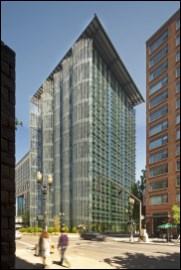by Brianna Crandall — April 25, 2014—The American Institute of Architects (AIA) and its Committee on the Environment (COTE) announced on April 22 their selections for the 18th annual AIA COTE Top Ten Project Award recipients—top ten examples of sustainable architecture and ecological design projects that protect and enhance the environment, as well as their selection for the second annual Top Ten Plus recipient—one past AIA COTE Top Ten Project Award recipient that has quantifiable metrics that demonstrate the true impact the sustainable design has achieved. The projects will be honored at the AIA 2014 National Convention and Design Exposition in Chicago.
AIA/COTE Top Ten Plus
AIA and COTE selected the Iowa Utilities Board / Office of the Consumer Advocate Office Building, design by BNIM, as the recipient of the Top Ten Plus. The building was selected in 2012 as a recipient of the AIA/COTE Top Ten Project Awards program. Located within the State of Iowa Capitol Complex, this project is an infill development of a former landfill. Following two years of occupancy, the exemplary regulator of utilities building is currently consuming 16.7 kBTU/sf per year, equivalent to an 81.5% reduction over the national average. As a result of total reduced energy needs, a roof-mounted 45 kW photovoltaic array currently provides 25 % of the buildings power needs up from the 13% originally projected.
Proper east-west orientation and a narrow north-south building configuration provide the most appropriate daylighting and natural ventilation opportunities. The building automation system identifies favorable exterior conditions, sending an e-mail to occupants when windows should be opened and closed. The automation system shuts down the associated zone’s heat pumps when windows are open, ensuring energy is not wasted, says AIA.
The stormwater treatment consists of a stormwater interceptor, infiltration basin, rain gardens, bioswales and pervious pavement. Stormwater enters the landscape through a limestone boulder sediment trap that slows water and controls erosion. Inside, a simple and replicable strategy (ultra-low-flow plumbing fixtures, faucet aerators and automatic sensors to reduce water flow) contributes to a water use reduction of 46% compared to a typical office building, adds the organization.
Real-time data is monitored and analyzed to improve building performance through a partnership with the State of Iowa Department of Administrative Services and the Iowa Energy Center. Building monitoring and tuning during the course of occupancy has yielded a few minor but impactful changes, notes AIA. Roller shades were installed at the north open office area to mitigate glare from the unanticipated snow reflectance, and lenses at specific Solatube diffusers were revised to provide more appropriate daylighting levels specific to occupant and location.
AIA/COTE Top Ten Projects
The COTE Top Ten Awards program, now in its 18th year, is said to be the profession’s best known recognition program for sustainable design excellence. The program celebrates projects that are the result of a thoroughly integrated approach to architecture, natural systems and technology. They make a positive contribution to their communities, improve comfort for building occupants, and reduce environmental impacts through strategies such as reuse of existing structures, connection to transit systems, low-impact and regenerative site development, energy and water conservation, use of sustainable or renewable construction materials, and design that improves indoor air quality.

The 2014 AIA/COTE Top Ten Projects are:
- Arizona State University Student Health Services, Tempe, AZ; Lake|Flato Architects + Orcutt|Winslow
- Bud Clark Commons, Portland, OR; Holst Architecture
- Bushwick Inlet Park, Brooklyn, NY; Kiss + Cathcart, Architects
- Edith Green-Wendell Wyatt (EGWW) Federal Building Modernization, Portland, OR; SERA Architects in association with Cutler Anderson Architects
- Gateway Center – SUNY-ESF College of Environmental Science and Forestry, Syracuse, NY; Architerra
- John and Frances Angelos Law Center, Baltimore, MD; Behnisch Architekten and Ayers Saint Gross
- Sustainability Treehouse, Glen Jean, WV; Design Architect: Mithun; Executive Architect/Architect of Record: BNIM
- The David and Lucile Packard Foundation Headquarters, Los Altos, CA; EHDD
- U.S. Land Port of Entry, Warroad, MN; Snow Kreilich Architects, Inc.
- Wayne N. Aspinall Federal Building and U.S. Courthouse, Grand Junction, CO; Design Architect: Westlake Reed Leskosky; Architect of Record: The Beck Group
Specific information on the sustainable features of each of the innovative, inspiring projects is available from the 2014 Winners Web page.




